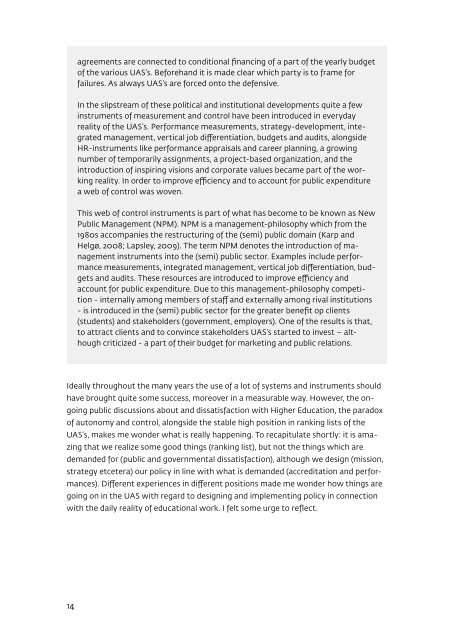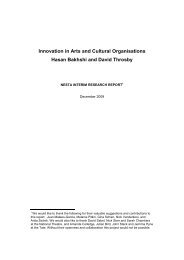Rumbling on performativity_Frits Simon
Rumbling on performativity_Frits Simon
Rumbling on performativity_Frits Simon
Create successful ePaper yourself
Turn your PDF publications into a flip-book with our unique Google optimized e-Paper software.
agreements are c<strong>on</strong>nected to c<strong>on</strong>diti<strong>on</strong>al financing of a part of the yearly budget<br />
of the various UAS’s. Beforehand it is made clear which party is to frame for<br />
failures. As always UAS’s are forced <strong>on</strong>to the defensive.<br />
In the slipstream of these political and instituti<strong>on</strong>al developments quite a few<br />
instruments of measurement and c<strong>on</strong>trol have been introduced in everyday<br />
reality of the UAS’s. Performance measurements, strategy-development, integrated<br />
management, vertical job differentiati<strong>on</strong>, budgets and audits, al<strong>on</strong>gside<br />
HR-instruments like performance appraisals and career planning, a growing<br />
number of temporarily assignments, a project-based organizati<strong>on</strong>, and the<br />
introducti<strong>on</strong> of inspiring visi<strong>on</strong>s and corporate values became part of the working<br />
reality. In order to improve efficiency and to account for public expenditure<br />
a web of c<strong>on</strong>trol was woven.<br />
This web of c<strong>on</strong>trol instruments is part of what has become to be known as New<br />
Public Management (NPM). NPM is a management-philosophy which from the<br />
1980s accompanies the restructuring of the (semi) public domain (Karp and<br />
Helgø, 2008; Lapsley, 2009). The term NPM denotes the introducti<strong>on</strong> of management<br />
instruments into the (semi) public sector. Examples include performance<br />
measurements, integrated management, vertical job differentiati<strong>on</strong>, budgets<br />
and audits. These resources are introduced to improve efficiency and<br />
account for public expenditure. Due to this management-philosophy competiti<strong>on</strong><br />
- internally am<strong>on</strong>g members of staff and externally am<strong>on</strong>g rival instituti<strong>on</strong>s<br />
- is introduced in the (semi) public sector for the greater benefit op clients<br />
(students) and stakeholders (government, employers). One of the results is that,<br />
to attract clients and to c<strong>on</strong>vince stakeholders UAS’s started to invest – although<br />
criticized - a part of their budget for marketing and public relati<strong>on</strong>s.<br />
Ideally throughout the many years the use of a lot of systems and instruments should<br />
have brought quite some success, moreover in a measurable way. However, the <strong>on</strong>going<br />
public discussi<strong>on</strong>s about and dissatisfacti<strong>on</strong> with Higher Educati<strong>on</strong>, the paradox<br />
of aut<strong>on</strong>omy and c<strong>on</strong>trol, al<strong>on</strong>gside the stable high positi<strong>on</strong> in ranking lists of the<br />
UAS’s, makes me w<strong>on</strong>der what is really happening. To recapitulate shortly: it is amazing<br />
that we realize some good things (ranking list), but not the things which are<br />
demanded for (public and governmental dissatisfacti<strong>on</strong>), although we design (missi<strong>on</strong>,<br />
strategy etcetera) our policy in line with what is demanded (accreditati<strong>on</strong> and performances).<br />
Different experiences in different positi<strong>on</strong>s made me w<strong>on</strong>der how things are<br />
going <strong>on</strong> in the UAS with regard to designing and implementing policy in c<strong>on</strong>necti<strong>on</strong><br />
with the daily reality of educati<strong>on</strong>al work. I felt some urge to reflect.<br />
14



